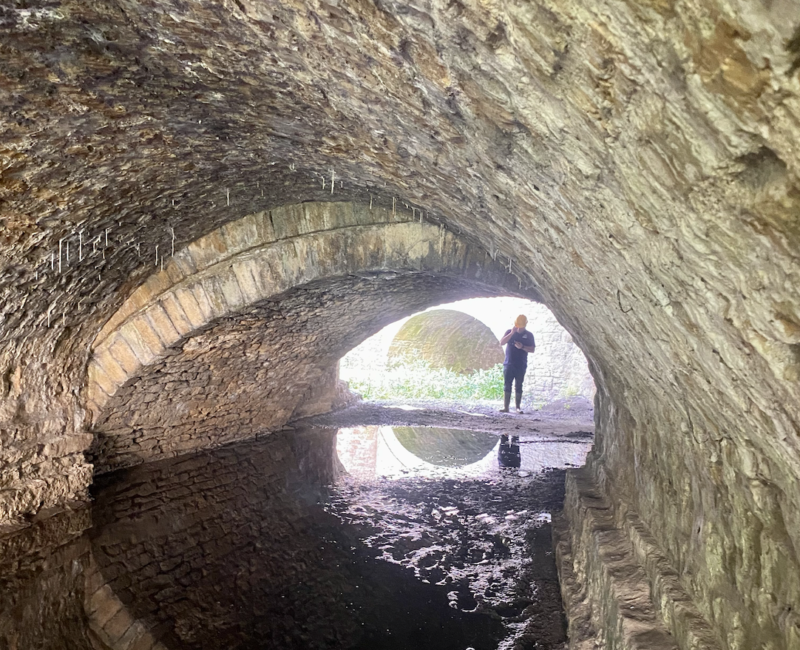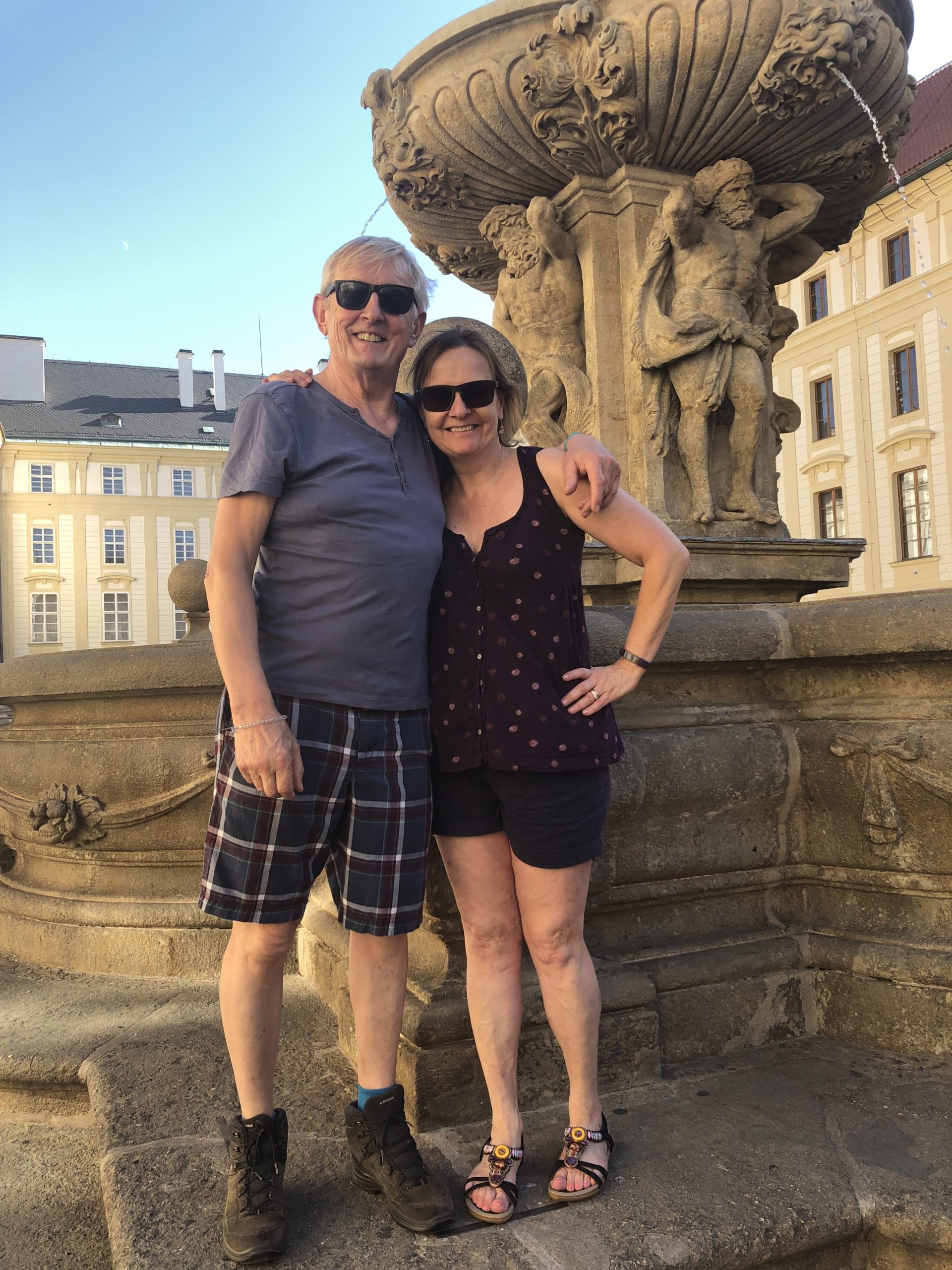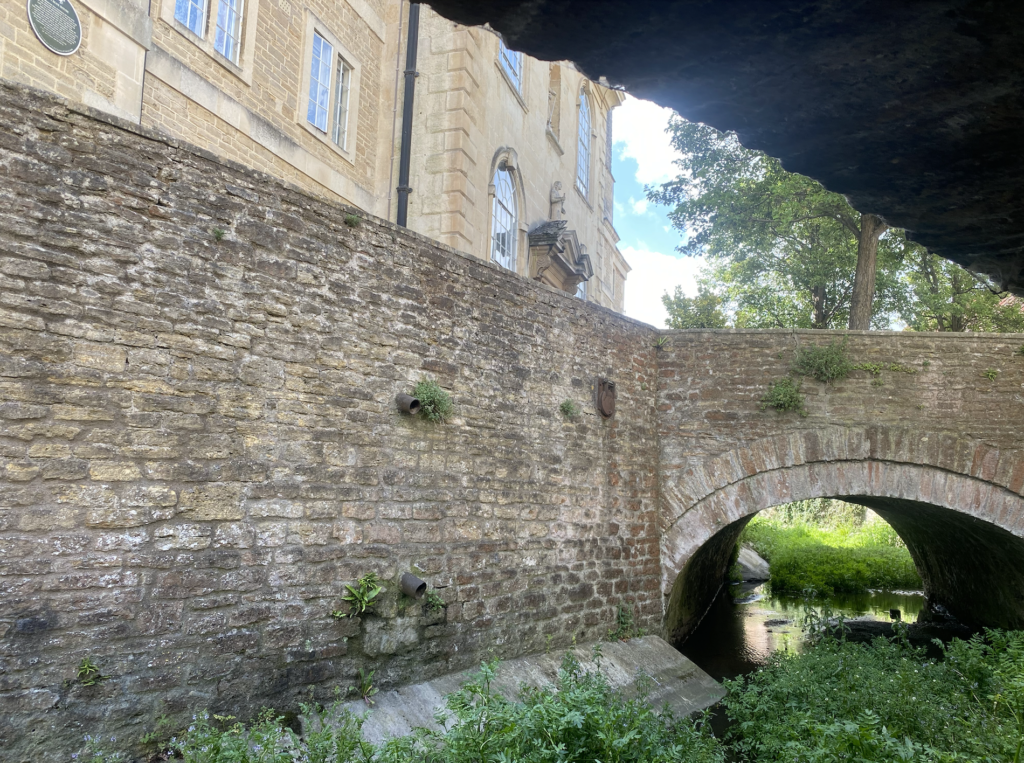
A different view of Frome. Photo: © F.Hardy
Peter Welcome to our travel podcast. We’re specialist travel writers and we’ve spent half a lifetime exploring every corner of the world.
Felice So we want to share with you some of our extraordinary experiences and the amazing people we’ve met along the way.
Peter This week, we’re going underground to explore a network of mysterious tunnels hidden beneath the ancient Somerset town of Frome. This happens to be where Felice and I now live. It lies 20 minutes south of Bath, and it’s got a long history dating back to Anglo Saxon times In the seventh century. In the Middle Ages, in the 13th and 14th century, and right up to the early 20th century, the town was internationally renowned for its blue dyed woollen cloth, made from woad – and its iron foundries.
Felice In fact, you can see some good examples of things created here in Frome. There’s King Alfred’s statue in Winchester.
Peter Yes, there’s Justice, the scales on top of the Old Bailey in London, the Central Criminal Courts.
Felice These were all manufactured in Frome a long time ago. So when you’re going about your daily business, whether it’s going shopping, going to the doctor, taking children to their schools, I wonder if you’ve ever thought about what lies beneath your feet, under the pavement, under the road? The history appears a bit like layers in a cake.
Peter Yes. Towns and cities have built on earlier towns and cities, so they stack up over the years. Excavations for underground railways or some new sewage system, or perhaps the footings for an office block or even a skyscraper, will occasionally reveal a plague pit or the mosaics of a Roman villa. But mostly this secret subterranean world remains inaccessible. But not always. Nor always…certainly in Frome.
The stories about the network of tunnels that run beneath the ancient town, are legion – passed down from generation to generation. Some are said to be waterways. Others stem from the industrial revolution. And then there are escape tunnels linking Frome with outlying villages or stately homes like Longleat, the ancestral home of the Marquesses of Bath – famous for the introduction in 1966 of lions and later tigers that have roamed its parkland ever since. Well, let’s just hope the cats don’t know about the tunnels.
Felice Quite a few of the tunnels have been blocked for decades or even centuries. Twenty years ago, Frome resident Robin Roland Hill started collecting these stories and, with a group of friends, he began digging and exploring at weekends.
Peter Now during the annual Frome Festival, which is an arts festival, the tunnel is open; part of the network is open to visitors equipped with safety helmets, torches, wellies and waterproof gloves. We met up for a preview of this with Robin’s fellow tunneller, Gary Kearley, and prepared ourselves to enter the actual tunnel network beneath the river Frome.
Felice Looking around the group, people are wearing all sorts of different things, but mainly old clothes, waterproof clothes. Most people had Wellington boots like us, but a couple were wearing trainers and one man was in cowboy boots. I’d brought along some woolly gloves, but I quickly discarded those because I was offered some gardening gloves and other people had washing up gloves and all sorts of surgical gloves, basically waterproof gloves. I wondered why that was.
Peter I can tell you that: rat urine – there’s lots of rat wee down there – and we’re told that you certainly don’t want any of that getting into a scratch or on any broken skin you can really get very ill with…I think it’s wells disease you get from that.
Felice And I certainly hope we don’t see any rats because I don’t like them very much.
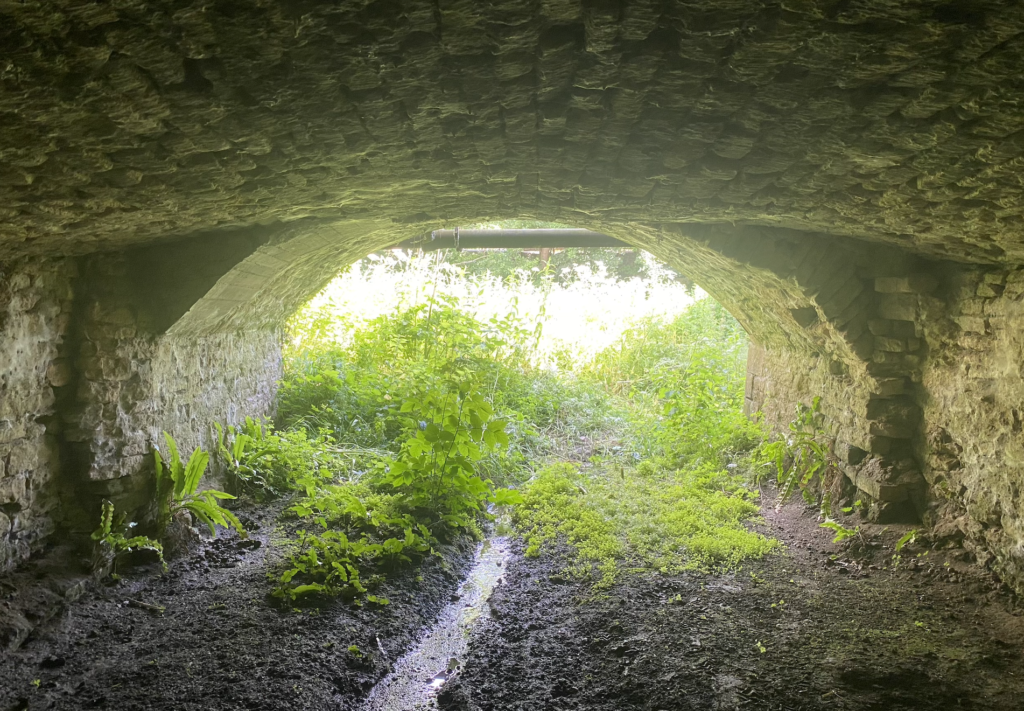
Don’t forget your wellies for the river tunnel. Photo: © F.Hardy
Peter So Gary told us what to do.
Gary Best way of going is to actually hold the rope and walk backwards. If you try and walk forwards, you’ll probably end up in the river. I’m going to go down and get myself ready. So if you’d like, make your way down.
Peter So now we’re going down towards the river. It’s quite a steep road with not in it nearly down.
Gary Well where we are alongside the River Frome from which the town obviously takes its name. I apologise to the historians amongst us for all the facts I get wrong. The town takes its name from the river, but back in the day when it was named, this was very much wider, very much shallower. The town, as most of you will know, was established in about 685 by St Oldham, who built a monastery, a sort of evangelical church here upon the hill, roughly where the church is today. And as always happens, you have a monastery and the town grows up around it. The town rapidly expanded.
Now, back in those days, the only way to get across the river was a ford…roughly where we are here now, but the town grew and grew that proved impractical. We’re told in about 1300 they built a nice wooden bridge across, but that was washed away in the floods and it wasn’t until the 1400s that we had our first proper stone bridge. The bridge was needed because the town had expanded so much that to get some more building land, they built up the banks on either side of the river. And of course, having built the banks up, you then can’t get down to a ford, so they put a nice bridge across. Back then, most of the town was upon the high land because this all flooded.
The bridge, as you can see, is fairly unique. We’re told there are only four bridges in the whole of England that have houses across the entire length. Originally the water flowed through one, two, three, four channels, but as the 1960s work was done to try and alleviate the flooding, so the river was channelled and deepened, which is why it is as you see it today. What we’re going to do is wind our way through the various arches and then go right underneath and see some of the historical stuff that’s buried beneath our bridge. So if you’d like to follow me, the footing can be a bit tight.
Peter So we’re now we’re going underneath the first arch of the bridge. I had no idea there was a bridge here at all. Oh, it’s quite spooky in here.
Gary You’re fortunate it’s dried up; this was all under water when we came down earlier in the week. So we are now under through Town Bridge, which is a bit of a misnomer because it’s not a town bridge. There are several, and this was built in 1451. So think knights in armour, Wars of the Roses, that sort of thing to put it into historical context.
As the town grew, this was sufficient for the trade, but the town grew on the back of the cloth industry and it was realised that this bridge wasn’t actually wide enough for two wagons to pass each other. So in 1667, so in the days when we still had the American colonies – they built an extension. We have documentary evidence for that fact. As they expanded this bridge, they obviously realised that they needed to make more of a statement. They needed people arriving in Frome to know they’d come somewhere special. So in 1797, so about the time the French Revolution when people were having their heads cut off in France, they built North Parade, which is the road that they were going to strike a passing museum at the top of the hill, and everybody was happy for a while.
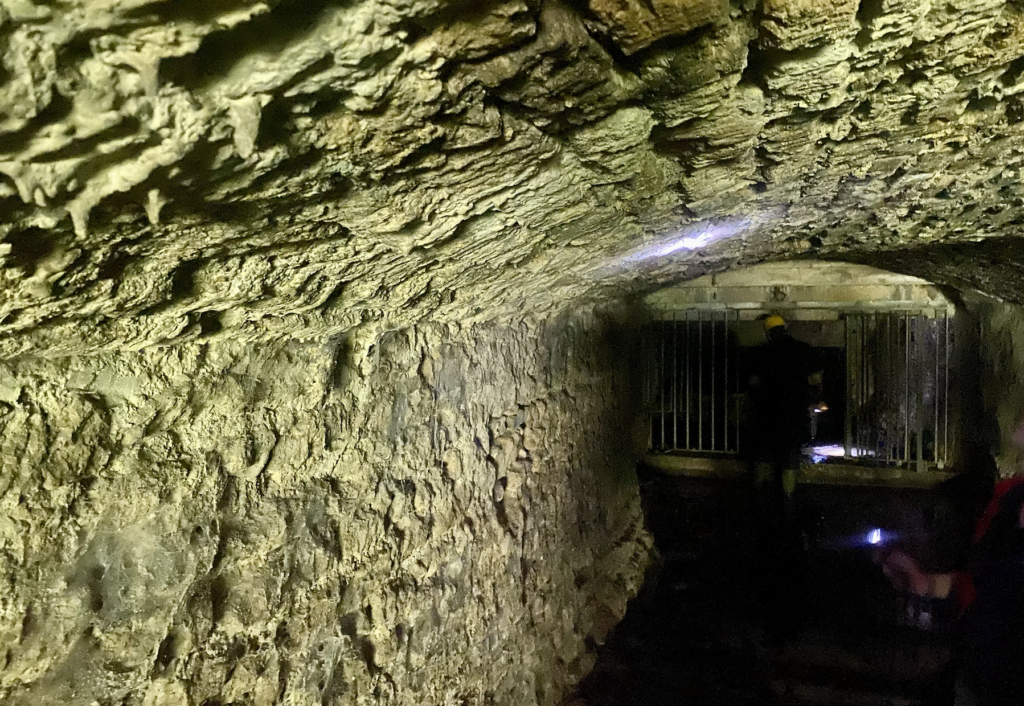
The metal grills. Photo: © F.Hardy
Felice I feel sorry for the people who’ve come in trainers.
Peter Here we have otter footprints in the mud, and they come down here to drink and then they cover up their tracks afterwards. The roof’s quite low here so we have to bend down a bit to get out. I can see sunlight at the end. Now we’re actually stepping into the river…well, the edge of the river.
Gary Where we…or you…are going to go next is through here. I can just shine a light. So when you go through, you want to go sideways like this. What it means then is if you hit something, an obstruction on the ceiling, you go that way rather than go over and on your back.
And when you get through to the other end of here, there’s a set of metal grills. It looks like a prison cell. And that was put up some years ago by the police. They were chasing somebody through the middle of town and he disappeared. They had no idea where this chap had gone. And one of the PCSOs (Police Community Support Officers)
said, ‘Well, I’ve been on the Frome Tunnels tour. I bet he’s under the bridge.’
So they found a ladder, came down. I’ll show you later where they found him hiding. And they thought, ‘We can’t have people doing this.’ So they put a metal bars up to stop anyone else going under there. So, I mean, you’re here to do a tunnel, so I’m sure you all want to go through there. Colin will go first. I’m going to go with Ann the other way to meet you, because I’ve been through there so many times, and then I can organise you at the other end.
Peter Okay, well, now I’m going underneath here…quite difficult.
Felice Go sideways.
Peter Yes, I’m going sideways. Stepping sideways through the tunnel. Water is quite deep, I feel like I’m in a salt mine or something. A bit claustrophobic and quite dark pushing. Fortunately other people are shining torches. Glad I’ve got a helmet on. My nose is almost in the water. Getting through it….Someone’s shining a torch in my direction now, which helps. And then we come to the end of the grill across the tunnel.
Gary Another couple of yards and you’re there.
Peter There’s a bone there.
Gary Mind your head on this one as you go through.
Felice In a minute you can sort of stand up a bit.
Gary So we are well underneath the town. Where I’m sitting is the original medieval road that came down from the top of town and down to the falls that I was talking about earlier. It’s not very wide, as you can see. The reason it’s not very wide is they’ve used half of the roadway to build the bridge. There’s a lot of water and that’s coming out of these two tubes. The one on the right goes up underneath the Westway shopping centre and that takes all the drain water and the rainwater from the top end of town.
The one on the left and that round the corner is where they found our runaway villain, hiding. Was suffering from hypothermia. He’d been down here for hours, apparently. But not so long ago, we had someone else come down here who did get away because he got through a manhole in the middle of the street outside the chemist and was obviously then confronted with these. He also made it out. So we think he must have gone up one of those two. But the one on the left, that takes all the water that flows down the middle of Cheap Street. So often when we come down here, we find toys and shoes and things that people have dropped in and have floated their way down. This is what we term to be a tunnel, which is actually effectively a waterway.
Felice You can stand up now. It’s very slippery.
Peter Yes, I can see that. Back into the sunlight. So what do you think of it so far, Felice?
Felice I didn’t like the very low bit. I mean, so low I almost couldn’t bend low enough.
Peter Yes, it’s quite claustrophobic. You understand why I don’t want to go potholing?
Felice I agree. It’s like the River Styx under there.
Gary I’ll take you back up the slope. So this was effectively a water tunnel. You’re now going to go and look at an industrial one.
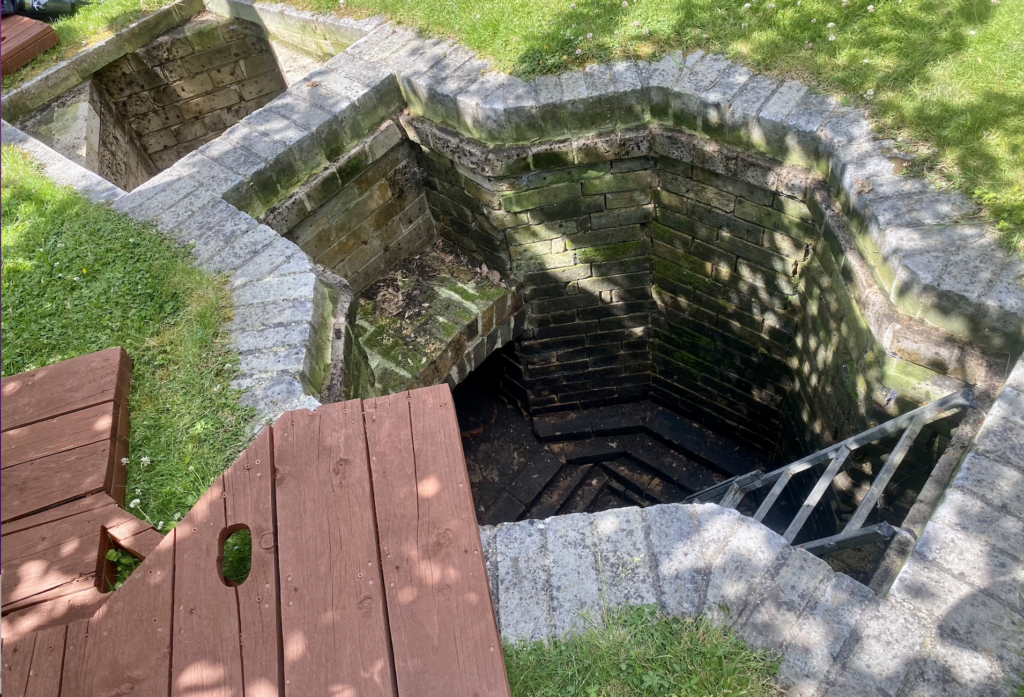
Garden tunnel. Photo: © F.Hardy
Peter And so on we went. This time we walked to a tunnel discovered beneath the lawn of a rather pretty riverside garden just beside the bridge.
Felice Well, it’s more like a flue than a tunnel, and it was hidden – so when we arrived, there were big wooden covers. I thought it must be something like a well underneath.
Peter Yes, they took this off and you could see quite a well-preserved tunnel with sort of soot marks on it…it looked like, anyway, in its cloth dyeing heyday, hot air from furnaces powered by local coal from Radstock, which is a mining area down the road, fed drying towers scattered all across the town and appeared that this was one of these ducts that led towards the dyeing tower, long since removed.
Felice Our guide said that we could go down and crawl through the tunnel if we wanted to. But when I looked and I saw that it was a size of a medium dog in height, I decided not to do it. One very brave man did go down there and all we could see were his feet poking out. And the other problem is that there’s no room to turn around, so if you then want to come out again, you have to reverse, which is pretty difficult in the dark and you don’t know where you’re going.

Tiny tunnel. Photo: © F.Hardy
Peter Back in the day, it seemed that Frome was a pretty smelly place. Residents had purple skin from the woad that was grown locally and they pong so badly from the urine used in the dyeing process that Queen Elizabeth I decreed that no Froomie was allowed within a mile of Her Majesty.
Felice Certainly it sounds like it smelt really horrible and the owners made lots of money out of it and woollen cloth was sold for soldiers’ uniforms all over the world. That included Napoleon’s army, Americans during the Civil War and the Russians in the 19th century.
Peter So water tunnels, industrial tunnels and also escape tunnels. Now, these were for hiding Catholic priests in Tudor times, fugitives in the Civil War, and then, of course, the Monmouth Rebellion in 1685, which was also known as the Pitchfork Rebellion, because it involved so many farm labourers. Now, this was a West Country Protestant attempt to overthrow Catholic King James second, who succeeded Charles II. And it was led by Charles’ illegitimate son, the Duke of Monmouth.
From the outset, it was doomed to failure. Monmouth was caught and executed after the Battle of Sedgemoor and some of his supporters were sentenced to death at the so- called Bloody Assizes, led by the notorious Hanging Judge Jeffreys. Twelve of these men were hung, drawn and quartered in Frome itself, and there are even tunnels that were upgraded in World War II for the safety of Field Marshal Lord Montgomery, who, surprisingly, when not in North Africa or Sicily, seemed to spend an awful lot of time in Frome in the months leading up to D-Day.
But there’s only so many tunnels you can see in a single visit. I think it’s time for our group to retire to the pub. Frome is pretty big on pubs: in 1956, it had 56 of them. Well, there’s a lot less today, but there’s some good ones. One in particular, The Lamb & Fountain, is so old that it’s even got a sarsen stone – as in Stonehenge – embedded in the roadway outside.
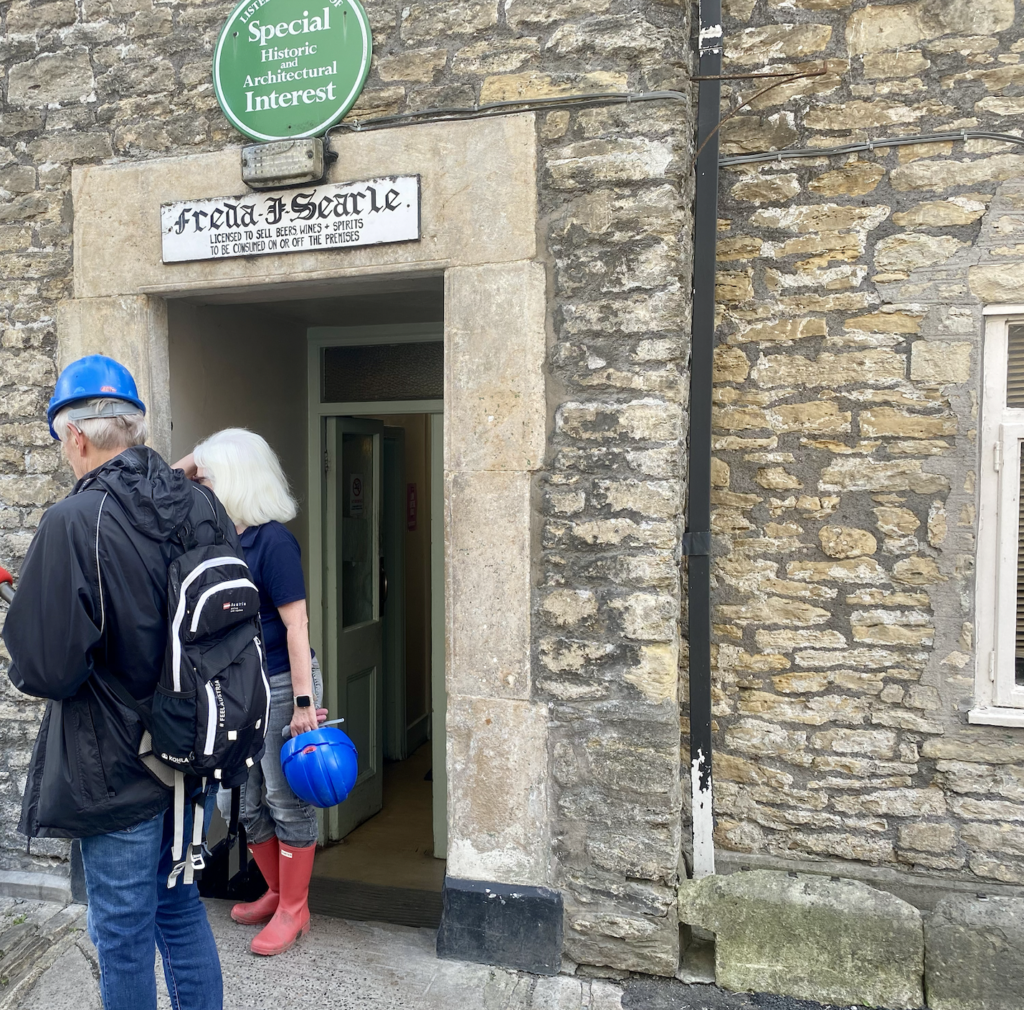
Outside the Lamb & Fountain pub. Photo: © F.Hardy
Well, I don’t think the pub goes back to kind of those sort of days, but it’s certainly been around for a good 600 or 700 years at least. And we went down to the cellar and looked at the original building, parts of the original building that remain and it’s really quite spectacular. But pubs are about beer and we soon armed ourselves with a pint or two and I have to say it got pretty noisy in there, so forgive the sound quality.
No adventure like exploring the Frome tunnels is complete without a ghost story or two, and there are plenty of those. Interestingly, as soon as Robin and his team started excavating the various tunnels all over Frome – and there are so many of them – there was a sudden spate of poltergeist activity. Well, that’s where it appeared to be, particularly in various pubs around the town. In one of them, a woman walked up to the bar, ordered drink, the barman poured the drink. The glass then shattered and flew across the room. She didn’t say anything apparently, she just turned on a heel and walked straight out. Then there was the mysterious story of the man who never was.
Man in pub It was like a rainy mid-week night was hardly anybody. And this scruffy guy came in, came to the bar and said, ‘I’d like a Newcastle Brown. So he said, ‘Ok, right. So you went to the fridge, got the Newcastle Brown, got the glass back to the bar. The guy wasn’t there, so he thought he was gone for the Gents. Didn’t turn up after five minutes, I thought he was doing something naughty in the Gents. Not in there. Went to the Ladies. Not in there. Four or five people were in the bar. ‘You see the scruffy guy, where did he go?’ ‘Haven’t seen anybody.’ So they pulled the drink away and said it really annoyed him. So he went to the office, replayed the tape, and he said there’s a video of me talking to thin air. And I said I was a metre away from this guy.
Robin And they’ve had the opposite. They locked up at night, gone up to the office, looked at the CCTV and realised there was somebody still drinking downstairs in the bar. They’d gone downstairs and this very well-spoken lady rang up and she said, ‘You must stop investigating the tunnels, doing any digging.’ And I said, ‘Why?’ She said, ‘Because there’s a triangle of tunnels from Frome to Clay Hill to Longleat and back again. And in the middle of that triangle is a chamber with the devil’s golden horn. And if you disturb it, the devil will return.’
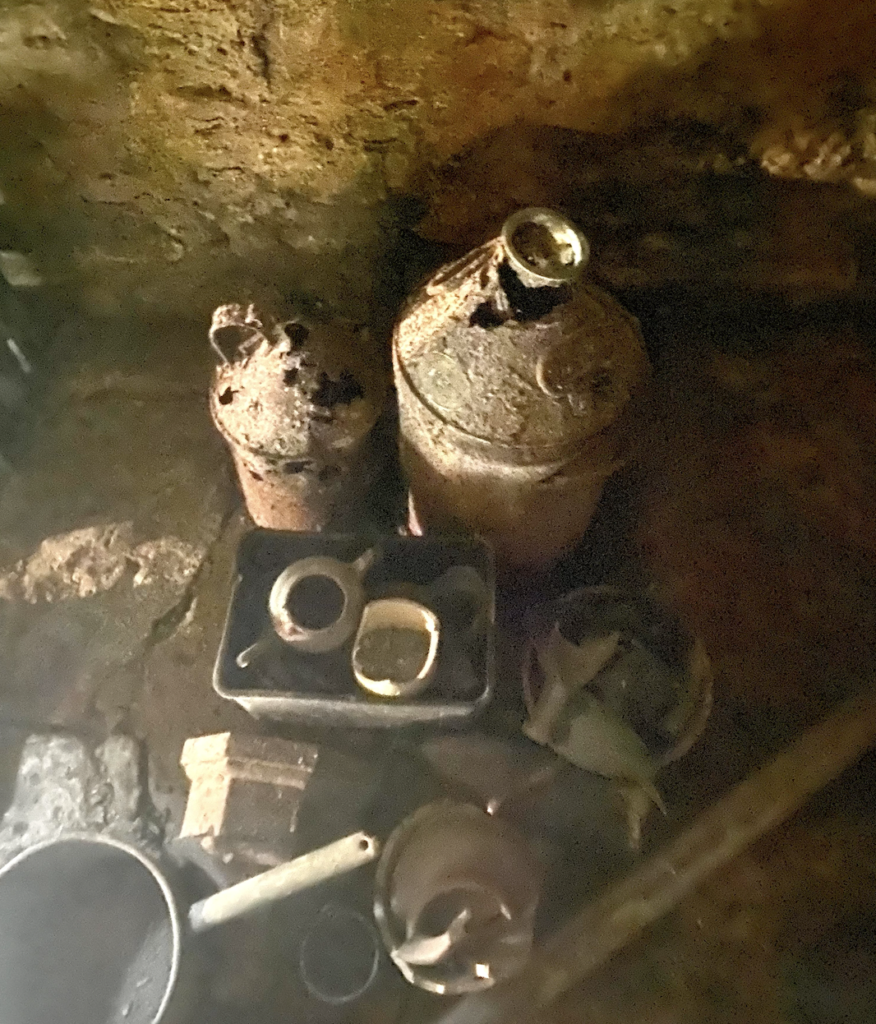
A few of the artefacts found under the pub. Photo: © F.Hardy
Peter So Robin, you started on this. How did that come about?
Robin It came about because we just moved house… into the house we lived in until very recently at Wallbridge 20 years ago. And I was restoring the cellar and my pick hammer went through what I thought was plaster. It turned out to be a hole, and a waft of air came through when I took the hammer out of the wall. So that’s not supposed to happen in cellars. I realised it was something on the other side. That’s when I thought, this is probably a Frome tunnel. But I’d heard the rumours, so started trying to find out and people said, ‘Oh, it’s all rubbish.’ Or other people said, ‘Oh yes, I’ve been in those; used to play in them when I was a boy.’ I went to the museum and they had nothing.
Peter So you got the tunnelling bug from that?
Robin Absolutely. Well, the story is fascinating, isn’t it? So together as a group of friends.
Peter So you started literally digging around. How many miles of tunnels are there, do you think?
Robin Well, there are three big ones that we have first-hand accounts for that stretch from the edge of Frome to outlying villages. So they’re all two, three, four miles long, and because they’ve all come from first-hand accounts and all the different tunnels in town, we think they were started building them during the Reformation and the Civil War. One was abandoned. So that’s insurance policies. But nobody builds a tunnel from the edge of a town to an outlying village a few miles away as a drain, or for fun.
The last point I’d make is that also all these accounts have come from first-hand, as I say, first-hand accounts from people of a later generation. Now they can’t all be making it up, surely? They all got together when they left school, said,’ I know what: let’s all tell everybody about tunnels that don’t exist.’ I don’t believe that. Some of them are going to be a bit exaggerated, of course, but no there’s definitely something there. The big ones are the ones we want to get into.
Peter Obviously, they’re divided into different brackets. There’s industrial tunnels and others.
Robin Definitely. So three different types: drains and waterways, of course, because we have a porous rock, so when you build a town you have to have decent drains. In the old days, digging a drain meant you had to have a man-sized hole. Secondly, industrial for waterworks and other such things and flues, as you have you seen today. But the interesting ones are the clandestine escape tunnels, whether they’re from a house to the churchyard or from one town to another settlement.
Peter And the stately homes around here, like Longleat has one.
Robin That has three.
Peter And then and then during World War Two, there was something connected with Montgomery.
Robin Yes. We’ve got obviously got some evidence of Montgomery being here for a couple of years, but also first-hand accounts, again, of…restored tunnels are not quite the right way to describe it, but the walls have been rendered. There’s even a photograph floating about from the 1950s where they found a dissolving World War II car in these tunnels.
Peter And this was to provide a safe place, a bomb shelter?
Robin I think more likely that it was to move Montgomery quickly from a hotel where he was stationed, to a safer location.
Peter Well, Robin that was absolutely fascinating, and we wish you the very best of luck with your future digging all the way beneath Frome.
Robin You’re very welcome. I hope you’ve enjoyed it.
Felice If you want to know more about the Frome Tunnel tour, visit FromeFestival.co.uk That’s Frome with one O. For another angle on the tunnel see Tales Of The Tunnels.
That’s all for now. If you’ve enjoyed the show, please share this episode with at least one other person! Do also subscribe on Spotify, i-Tunes or any of the many podcast providers – where you can give us a rating. You can subscribe on Spotify, Apple Podcasts or any of the many podcast platforms. You can also find us on Twitter, Facebook and Instagram. We’d love you to sign up for our regular emails to [email protected]. Until next week, stay safe.
© Action Packed Travel

- Join over a hundred thousand podcasters already using Buzzsprout to get their message out to the world.
- Following the link lets Buzzsprout know we sent you, gets you a $20 Amazon gift card if you sign up for a paid plan, and helps support our show.

